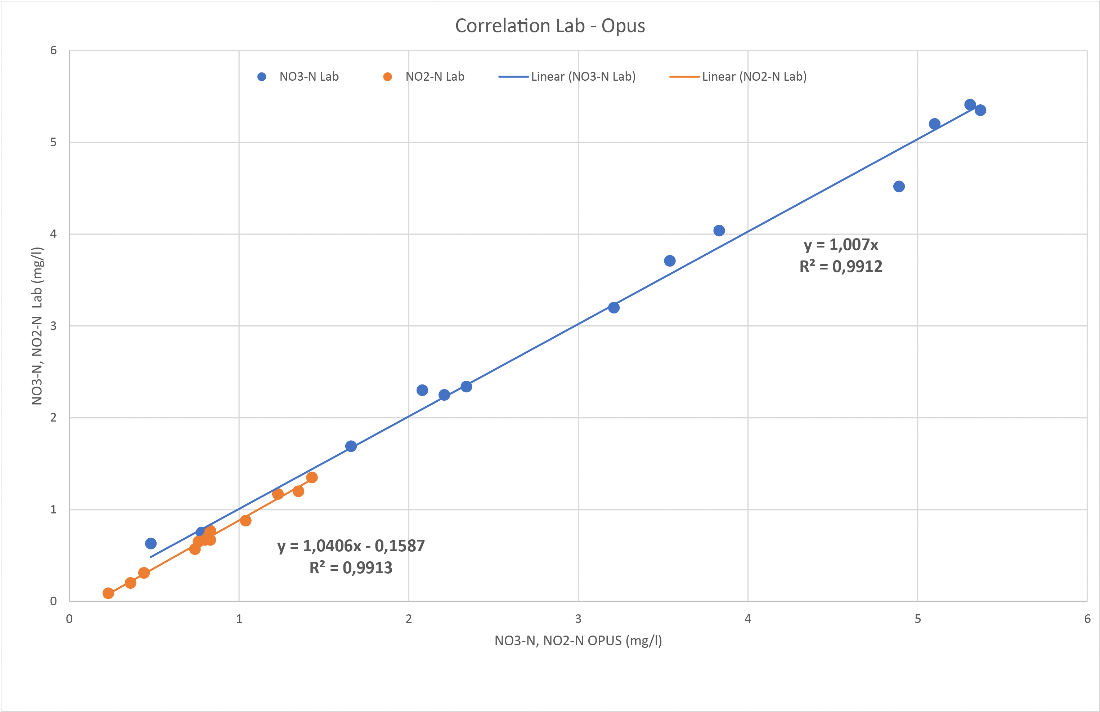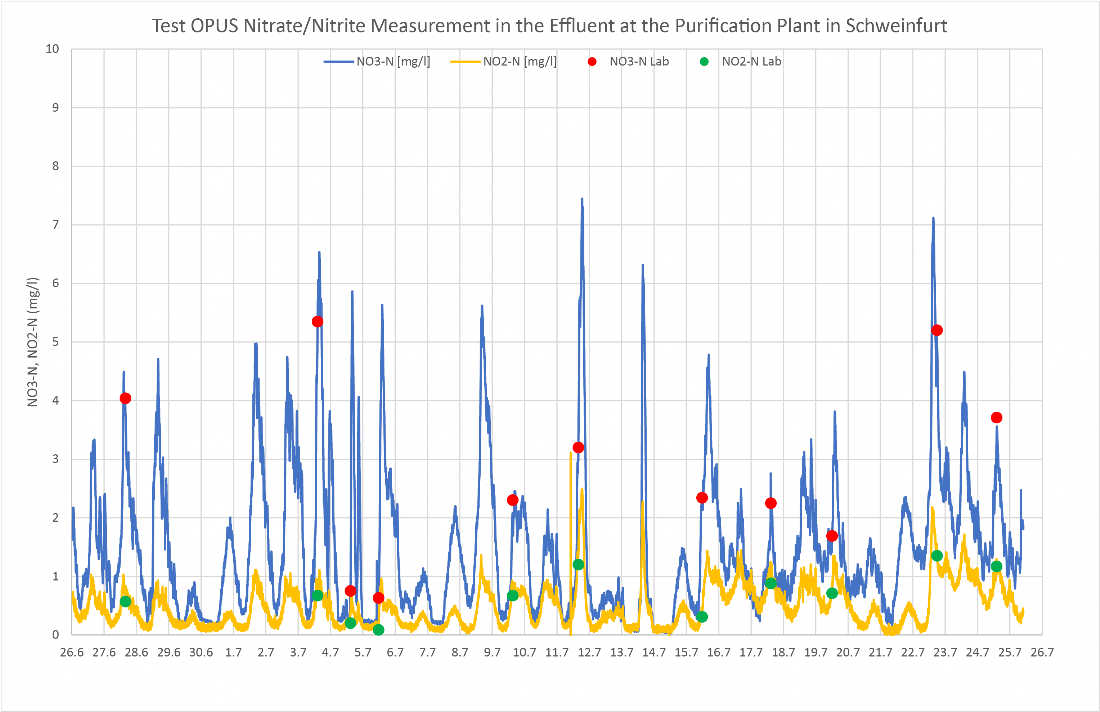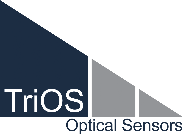Nitrate/Nitrite Measurement
in the effluent of the biology at the purification plant in Schweinfurt, Germany





Application Description
The Schweinfurt wastewater treatment plant, which is designed for 250,000 PE, operates its biological treatment stage via four intermittently aerated lines. Each line is equipped with an ion-selective ammonium/nitrate combination probe (ISE) for control. The ISE probes, which are relatively inexpensive to purchase, work with an electrochemical process which is subject to a drift in the measured values due to changes in the electrode properties over time. This drift can be further increased by impurities in the wastewater. Therefore, frequent calibrations via comparative laboratory measurements are necessary. The joint discharge of the four aeration lines is again monitored with an ammonium analyzer and an optical nitrate probe. In addition to direct control tasks, these also serve to monitor and check the plausibility of the ISE probes.
Task
For the discharge measurements of the biological treatment stage, the Schweinfurt wastewater treatment plant has a measuring building with an overflow tank into which a partial flow of the wastewater is continuously pumped. The optical NOx probe used so far is installed in this overflow tank in addition to the filtration for the ammonium analyzer.
However, it does not provide satisfactory agreement with the nitrate laboratory comparison measurements and therefore has to be recalibrated again and again, which is normally not expected for an optical nitrate measurement.
For precise control and monitoring of the ISE probes, the NOx probe is therefore not well suited. A new, more powerful probe is to be purchased at this point.
Another disadvantage is the relatively long response time of NOx measurement. With the current use of the probe directly in the activated sludge, averaging is necessary because the high turbidity caused by the sludge flocs causes higher fluctuations in the individual measurements. Therefore, averaging over 10 - 15 minutes (3-5 individual measurements) is usually set to smooth the hydrograph. In case of very fast changes of the nitrate concentration in the wastewater, an exact comparison measurement in the laboratory is thus considerably more difficult.
Solution
The already existing filtration for the ammonium analyser is used and the OPUS UV probe is installed in the bypass by means of a flow cell. The optical measurement in the clear medium allows the path length of the sensor to be increased from 1 to 2 mm, thus achieving more accurate measurement results.
Furthermore, averaging is not necessary, since the individual measurements are stable after filtration. The set measuring interval is 2 min. The dynamics of the fast processes are thus reflected without damping.
The OPUS UV probe is equipped with a nitrate/nitrite calibration, so that the nitrogen balance of the measuring point can be recorded correctly.
Test Results
During the observed period of one month, the company‘s own laboratory regularly carried out comparative measurements for nitrate and nitrite using cuvette tests. These show excellent correlation with the online values of the OPUS sensor for nitrate over the entire measuring range. This is confirmed by an impressive correlation graph with a slope of almost 1 and a coefficient of determination of 0.99.
Also for nitrite a very good correlation can be seen despite the low measuring range. A small offset of approx. - 0.15 mg/l would even optimise the measurement results. However, no further adjustments of the settings were made during the trial period.

Correlation of the comparative laboratory measurements with the online values of the OPUS UV test setup in the biology discharge at the sewage treatment plant Schweinfurt from 26.6 - 26.7.2019
What is striking about the course of the online measured values is that nitrite is repeatedly detected in clearly measurable quantities (up to 2 mg/l). Together with nitrate, the nitrite shows a dynamic daily hydrograph with mostly very fast and large changes in measured values. Overall, however, the sum of nitrate and nitrite remains well below 10 mg/l even in the peaks.

Graphs of the OPUS measurement values for NO3-N (blue line) and NO2-N (yellow line) as well as the laboratory comparison measurements for NO3-N (red points) and NO2-N (green points)
The comparative laboratory measurements in these phases show that the dynamics of the processes are realistically reproduced by the OPUS UV probe even during a strong increase or decrease of the nitrate and nitrite values. Also in the steep flanks of the concentration peaks a very good correlation with the online values can be seen. A damping by averaging would lead to significantly higher deviations here.
Conclusion
The results show that a spectral probe must necessarily be used at this measuring point, which can detect nitrate and nitrite in a differentiated manner. Besides nitrate, nitrite is always present in non-negligible concentrations, which interferes with an NOx measurement and produces deviating measurement results.
The optical properties of nitrate and nitrite are similar. They absorb UV light of almost the same energy or wavelength. If the UV measurement is carried out at only one wavelength, as is the case with optical NOx sensors, it is not possible to differentiate between these two parameters. The result is output as a pure nitrate value and differs significantly from the real concentrations in the presence of nitrite. Only with a spectral evaluation over a larger wavelength range with sufficient resolution, as is the case with the OPUS UV probe, can these two parameters be determined simultaneously and accurately.
The installation of the probe in the bypass is of great advantage at this point. In a clear medium, measured values can in principle be determined more stably and precisely. Damping is also not necessary. Fast processes can be reproduced realistically.
Since the filtration is already present, no additional investment costs are incurred in this case. There is even no need to purchase an automatic cleaning system such as a wiper or air compressor. Assuming that operation in the bypass is gentler on the sensor itself and causes less wear and tear, the balance of the total costs of a bypass measurement is much more favourable overall compared to an immersion probe.
The operator of the sewage treatment plant was also convinced by the performance of the OPUS UV probe. The reliable and precise results in real time enable him to effectively monitor and optimize the control of the processes in the biological treatment.
The acquisition of the OPUS UV probe for the nitrate/nitrite determination was approved and put into operation in January 2020.

